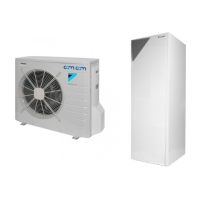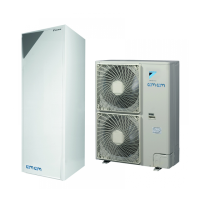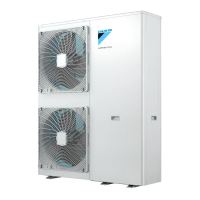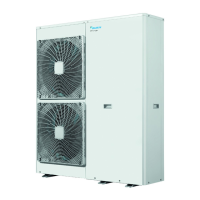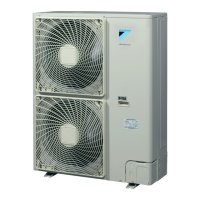5 Application guidelines
Installer reference guide
18
ERGA04~08DAV3(A) + EHVH04+08S23DAV
Daikin Altherma – Low temperature split
4P499573-1 – 2017.12
▪ You can read out the energy data:
▪ Per month
▪ Per year
INFORMATION
The calculated produced heat and consumed energy are
an estimation, the accuracy cannot be guaranteed.
5.5.1 Produced heat
INFORMATION
The sensors used to calculate the produced heat are
calibrated automatically.
▪ Applicable for all models.
▪ The produced heat is calculated internally based on:
▪ The leaving and entering water temperature
▪ The flow rate
▪ The power consumption of the anti-legionella heater in the
domestic hot water tank
▪ Setup and configuration:
▪ No additional equipment needed.
▪ Measure the capacity (resistance measurement) of the anti-
legionella heater and set the capacity via the user interface.
Example: If you measure an anti-legionella heater resistance of
24Ω, the capacity of the heater at 230V is 2200W.
5.5.2 Consumed energy
You can use the following methods to determine the consumed
energy:
▪ Calculating
▪ Measuring
INFORMATION
You cannot combine calculating the consumed energy
(example: for backup heater (if applicable)) and measuring
the consumed energy (example: for outdoor unit). If you do
so, the energy data will be invalid.
Calculating the consumed energy
▪ The consumed energy is calculated internally based on:
▪ The actual power input of the outdoor unit
▪ The set capacity of the backup heater (if applicable) and anti-
legionella heater
▪ The voltage
▪ Setup and configuration: To get accurate energy data, measure
the capacity (resistance measurement) and set the capacity via
the user interface for:
▪ The backup heater (step1 and step2) (if applicable)
▪ The anti-legionella heater
Measuring the consumed energy
▪ Applicable for all models.
▪ Preferred method because of higher accuracy.
▪ Requires external power meters.
▪ Setup and configuration: When using electrical power meters, set
the number of pulses/kWh for each power meter via the user
interface.
INFORMATION
When measuring the electrical power consumption, make
sure ALL power input of the system is covered by the
electrical power meters.
5.5.3 Normal kWh rate power supply
General rule
One power meter that covers the entire system is sufficient.
Setup
Connect the power meter to X5M/5 and X5M/6.
Power meter type
In case of… Use a… power meter
▪ Single-phase outdoor unit
▪ No backup heater or backup
heater supplied from a single-
phase grid
Single-phase
In other cases (i.e. a three-phase
outdoor unit and/or a backup
heater connected to a three-
phase grid)
Three-phase
Example
Single-phase power meter Three-phase power meter
A Outdoor unit
B Indoor unit
C DHW tank
a Electrical cabinet (L
1
/N)
b Power meter (L
1
/N)
c Fuse (L
1
/N)
d Outdoor unit (L
1
/N)
e Indoor unit (L
1
/N)
f Backup heater (L
1
/N)
g Anti-legionella heater (L
1
/N)
A Outdoor unit
B Indoor unit
C DHW tank
a Electrical cabinet (L
1
/L
2
/L
3
/N)
b Power meter (L
1
/L
2
/L
3
/N)
c Fuse (L
1
/L
2
/L
3
/N)
d Fuse (L
1
/N)
e Outdoor unit (L
1
/L
2
/L
3
/N)
f Indoor unit (L
1
/L
2
/L
3
/N)
g Backup heater (L
1
/L
2
/L
3
/N)
h Anti-legionella heater (L
1
/N)
Exception
▪ You can use a second power meter if:
▪ The power range of one meter is insufficient.
▪ The electrical meter cannot easily be installed in the electrical
cabinet.
▪ 230 V and 400 V three-phase grids are combined (very
uncommon), because of technical limitations of power meters.
Final English - Tanslations in progress

